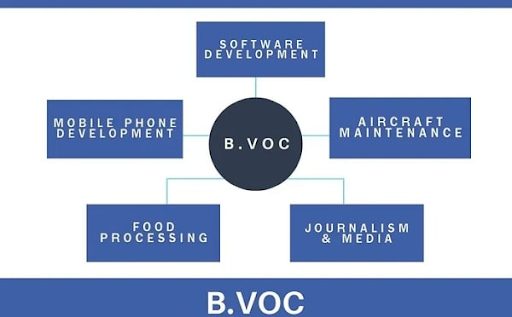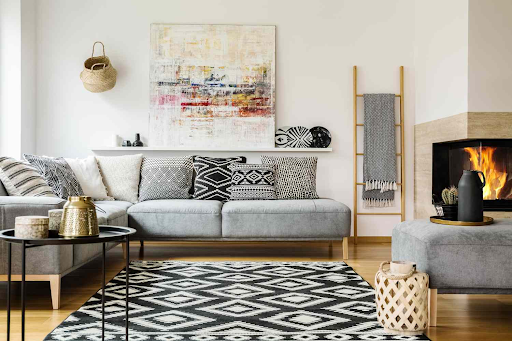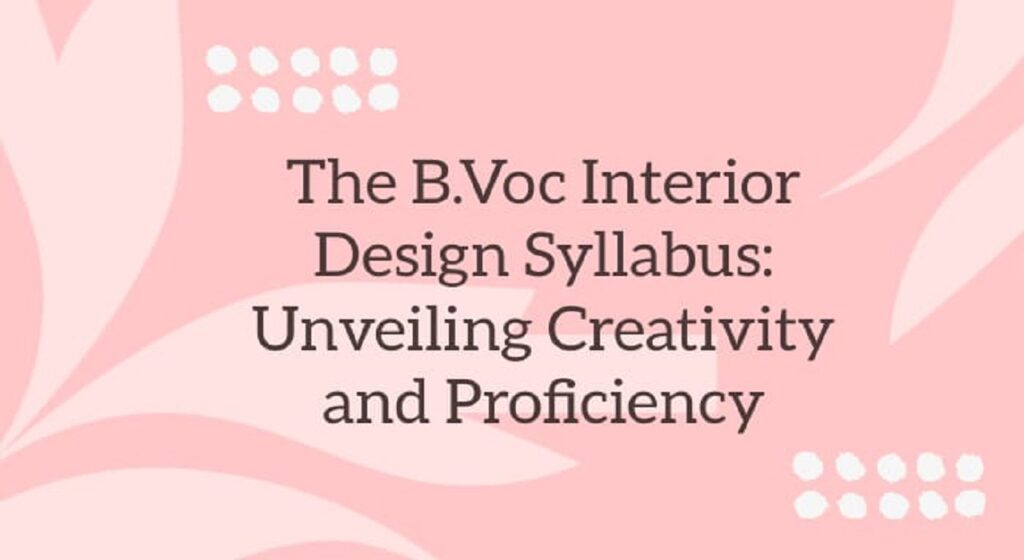Introduction :
Interior design is a captivating blend of artistry and functionality, transforming spaces into captivating havens. For those aspiring to step into this dynamic field, pursuing a B.Voc (Bachelor of Vocation) in Interior Design could be the perfect avenue. This blog serves as a comprehensive guide to understanding the B.Voc Interior Design syllabus, its significance in nurturing creativity and proficiency, and the exciting career opportunities it opens up.

The B.Voc Interior Design Syllabus: Nurturing Creativity and Proficiency
The B.Voc Interior Design program is designed to equip students with a strong foundation in the art and science of interior design. It encompasses various aspects, from spatial planning and color theory to furniture design and project management. Let’s delve into the key components of the syllabus:
1. Foundation Courses: The journey starts with foundational courses that introduce students to the fundamentals of design, drawing, and art history. These courses lay the groundwork for creative thinking and visual expression.
2. Spatial Planning and Design: Understanding how to optimize space is at the core of interior design. Students learn spatial analysis, floor planning, and ergonomics to create functional and aesthetically pleasing spaces.
3. Materials and Textiles: Knowledge of various materials and textiles is crucial for interior designers. The syllabus includes a deep dive into understanding the characteristics, applications, and sourcing of materials used in interior design projects.
4. Color Theory and Lighting: This module explores the psychology of color, color harmony, and its impact on interior spaces. Lighting design is also covered, emphasizing the importance of proper lighting to enhance ambiance.
5. Furniture Design: Interior designers often need to customize furniture to suit a specific design concept. Students learn about furniture styles, construction techniques, and sustainable design practices.
6. Computer-Aided Design (CAD): Proficiency in CAD software is vital for turning design concepts into visual representations. Students are taught how to create 2D and 3D designs, enabling effective communication with clients and contractors.
7. Interior Design Studio: The heart of the syllabus lies in the design studio, where students apply theoretical knowledge to real-world projects. They develop the skills to conceptualize, plan, and execute interior design projects from start to finish.
8. Project Management: Successful execution of design projects involves effective project management. Students learn about budgeting, time management, and client communication to ensure projects are delivered seamlessly.
9. Professional Practice: To prepare students for the industry, this module covers ethical considerations, business practices, and legal aspects of interior design.

Career Prospects
Graduates of the B.Voc Interior Design program are well-equipped to enter the world of interior design with confidence and competence. They can explore various career paths, including:
– Residential Interior Designer
– Commercial Interior Designer
– Furniture Designer
– Set Designer (for films, TV, and theater)
– Exhibition Designer
– Retail Space Designer
– Interior Stylist
– Design Consultant
The combination of practical skills and creative vision obtained through the syllabus empowers graduates to make a meaningful impact in the industry.

Frequently Asked Questions (FAQs)
1. Is a B.Voc in Interior Design solely focused on creativity?
No, while creativity is a significant aspect, the B.Voc Interior Design syllabus also emphasizes practical skills such as spatial planning, project management, and material knowledge to ensure graduates are well-rounded professionals.
2. Are CAD skills essential for interior designers?
Yes, proficiency in Computer-Aided Design (CAD) software is essential for modern interior designers. It enables them to create accurate visual representations and collaborate effectively with clients and contractors.
3. What is the duration of a B.Voc Interior Design program?
The duration varies but generally spans three years, divided into multiple semesters. It includes a balance of theoretical learning, practical projects, and internships.
4. How does this program prepare students for real-world projects?
The program’s design studio courses simulate real-world projects, allowing students to apply their knowledge to practical scenarios. They learn to address challenges, work within constraints, and develop innovative solutions.
5. Can I pursue postgraduate studies after completing a B.Voc in Interior Design?
Absolutely. Graduates can further specialize in areas such as sustainable design, architectural visualization, or design management by pursuing postgraduate degrees or diploma programs. Visit https://inifdchennai.com/careersinifd/

Conclusion
A B.Voc in Interior Design not only fuels your creative passions but also equips you with the skills needed to thrive in a competitive industry. The comprehensive syllabus blends theory, hands-on experience, and practical knowledge to create proficient and innovative interior designers ready to shape captivating spaces. Whether you envision yourself designing cozy homes or transforming commercial spaces, this program paves the way for a rewarding career that combines imagination and expertise.

